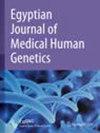Mutational landscape of BRCA gene mutations in Indian breast cancer patients: retrospective insights from a diagnostic lab
IF 1.2
Q4 GENETICS & HEREDITY
引用次数: 0
Abstract
Presence of Germline mutations in the BRCA1 and BRCA2 genes is the most significant epidemiological factor for breast cancer (BC), where germline BRCA1 (gBRCA 1) mutation increases the risk for BC by 59–87% and gBRCA 2 mutation increases the risk by 38–80%. In this retrospective study, we have analyzed NGS-based genetic data for samples received at our laboratory for genetic testing over a three-year period to understand the prevalence and pattern if any of BRCA1 and BRCA2 mutations in Indian breast cancer patients. BRCA gene sequencing using NGS was performed in 395 consecutive cases of BC referred for testing to our lab between 2021 and 2023. Genetic analysis of mutations BRCA 1 and BRCA 2 genes resulted in 115 (29%) positive patients. Out of 115 patients, 79 reported BRCA1 mutations, whereas 36 had BRCA2 mutations. Exon 10 (57.3%) of BRCA1 and exon 11 (52%) of BRCA2 were the most mutated exons observed in this study. The c.1961delA (26.4%) variant, followed by the c.68_69delAG (22.7%) variant in BRCA1, and the c.6373delA (20.5%) variant in BRCA2, were the most common mutations found in our study. Our data shows positive correlation of younger age group (20–45 years) with BRCA positive status (Chi-square p value = 0.001). BRCA mutation prevalence was 29.1% in our data which is higher than Western countries. Based on our findings BRCA screening looks imperative for women with BC especially younger women (< 50 years), as family history based BRCA testing would miss out many BRCA positive candidates which could benefit from PARP therapy options.印度乳腺癌患者 BRCA 基因突变情况:一家诊断实验室的回顾性见解
BRCA1 和 BRCA2 基因的种系突变是乳腺癌(BC)最重要的流行病学因素,其中种系 BRCA1(gBRCA 1)突变会使乳腺癌风险增加 59-87%,gBRCA 2 突变会使乳腺癌风险增加 38-80%。在这项回顾性研究中,我们分析了实验室在三年内收到的基因检测样本的 NGS 基因数据,以了解印度乳腺癌患者中 BRCA1 和 BRCA2 基因突变的发生率和模式。在 2021 年至 2023 年期间,我们使用 NGS 对转介到我们实验室进行检测的 395 例 BC 连续病例进行了 BRCA 基因测序。对 BRCA 1 和 BRCA 2 基因突变的遗传分析结果显示,有 115 例(29%)阳性患者。在 115 例患者中,79 例报告了 BRCA1 基因突变,36 例报告了 BRCA2 基因突变。BRCA1 的第 10 号外显子(57.3%)和 BRCA2 的第 11 号外显子(52%)是本研究中观察到的最多突变的外显子。BRCA1 中的 c.1961delA(26.4%)变异、c.68_69delAG(22.7%)变异和 BRCA2 中的 c.6373delA(20.5%)变异是本研究中发现的最常见变异。我们的数据显示,较年轻的年龄组(20-45 岁)与 BRCA 阳性状态呈正相关(Chi-square p 值 = 0.001)。在我们的数据中,BRCA 基因突变发生率为 29.1%,高于西方国家。根据我们的研究结果,BRCA 筛查对于患有乳腺癌的女性,尤其是年轻女性(小于 50 岁)来说势在必行,因为基于家族史的 BRCA 检测会漏掉许多 BRCA 阳性的候选者,而这些候选者可以从 PARP 治疗方案中获益。
本文章由计算机程序翻译,如有差异,请以英文原文为准。
求助全文
约1分钟内获得全文
求助全文
来源期刊

Egyptian Journal of Medical Human Genetics
Medicine-Genetics (clinical)
CiteScore
2.20
自引率
7.70%
发文量
150
审稿时长
18 weeks
 求助内容:
求助内容: 应助结果提醒方式:
应助结果提醒方式:


